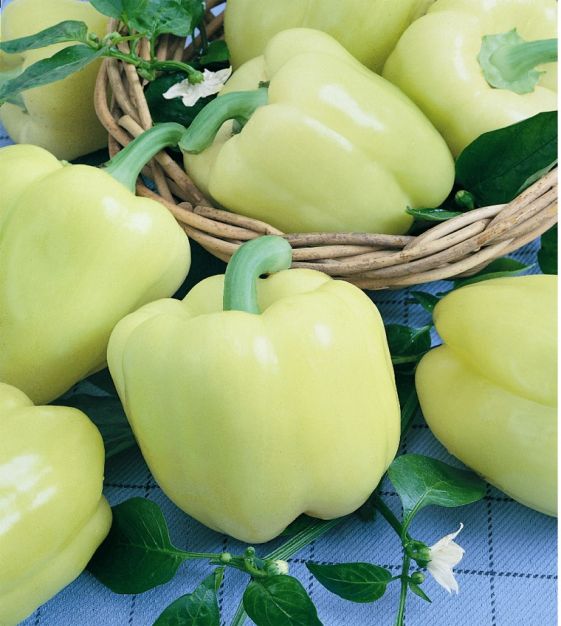Back to Top
Diamond Bell Pepper (white)
75 days. Be the first on your block to grow this tawny-alabaster, American-bred beauty. Rarely seen in even the finest of produce markets, its medium-thick fleshed, blocky fruits have a mouth-watering, rich flavor and a sweet, juicy crunch. Borne on sturdy, prolific, 2' high plants, Diamond remains translucent ivory for quite a while before gradually maturing to pale yellow and, finally, scarlet-red. Harvest while lustrous alabaster, and julienne it in combination with green, red, orange and yellow Peppers with thinly sliced Red Onions for a sweet rainbow salad dressed with a citrus vinaigrette. Or, saute the colorful combination of julienned Peppers in a little olive oil until crisp-tender; then, add a bit of your favorite vinegar, lemon zest and a touch of herbs as a tasty and colorful layer over open-faced, grilled Eggplant and goat cheese stacked baguettes. (OP.)
One packet of about 20 seeds
One packet of about 20 seeds
- Buy 10 for $4.55 each and save 10%
- Buy 50 for $3.80 each and save 25%
- Information
- Gardening Tips
Peppers ought to be experienced right off the vine after harvest. Best raised as transplants sown indoors 6 to 8 weeks prior to setting out in full sun after the last spring frost date, they like rich soil and need regular additional fertilizing. They need at least 10 weeks of hot weather to produce well and should be enjoyed soon after harvest. To protect Peppers from sunburn, pinch plants to encourage leaf growth. Keep Peppers picked to sustain production levels. At the height of harvest, hold a roast. Place picked Peppers on a hot grill, turning them until all sides are charred and blistered black. Put them in a paper bag on a tray and close the bag tight so the steam detaches the skins. Once cool, remove the skins, stems, membrane and seeds, and freeze in airtight plastic bags for use through the winter. (See Hot Chile Peppers for Cajun Bell Peppers, which earned a spot in the Hot Chile Peppers with a 100 to 1,000 Scoville heat rating.) Deer resistant.
Average seed life: 2 years.
Average seed life: 2 years.
Peppers ought to be experienced right off the vine after harvest. Best raised as transplants sown indoors 6 to 8 weeks prior to setting out in full sun after the last spring frost date, they like rich soil and need regular additional fertilizing. They need at least 10 weeks of hot weather to produce well and should be enjoyed soon after harvest. To protect Peppers from sunburn, pinch plants to encourage leaf growth. Keep Peppers picked to sustain production levels. At the height of harvest, hold a roast. Place picked Peppers on a hot grill, turning them until all sides are charred and blistered black. Put them in a paper bag on a tray and close the bag tight so the steam detaches the skins. Once cool, remove the skins, stems, membrane and seeds, and freeze in airtight plastic bags for use through the winter. (See Hot Chile Peppers for Cajun Bell Peppers, which earned a spot in the Hot Chile Peppers with a 100 to 1,000 Scoville heat rating.) Deer resistant.
Average seed life: 2 years.
Average seed life: 2 years.




